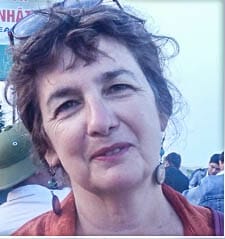Editor's Note - This is part of Picture this Post's series - CHOREOGRAPHERS' EYES - DANCERS EXPLAIN DANCE. Find more here.
When playwright Paul Pasulka asked choreographer Ellyzabeth Adler (founder of Chicago Danztheatre Ensemble) to work with him on The Agency Theatre Collective’s production of Skin for Skin, it was easy for Ellyzabeth to agree. She explains, “The most important thing we can do as artists is to use our art to make change.”
(Read the full review of Skin for Skin here —“ Agency Theater Collective Presents SKIN FOR SKIN Review – Abu Ghraib Revisited.”)
Amy Munice, Editor of Picture this Post (PTP), has asked Ellyzabeth Adler (EA) to share her insider’s perspective on how to make a script such as Skin for Skin come to life for audiences. She shares—
PTP: It strikes me that this production made just the right balance between being graphic about the violence and leaving the rest to imagination. Was this a conscious aim? Did your collaborative team struggle with this or have a clear idea on how to achieve this objective?
EA: We had pre rehearsal meetings with the playwright and the director where this was discussed. It was decided to strike this balance because we did not want people to shut off from the play, which we thought would happen if the show had too much violence. Also, the words themselves are very powerful, allowing them to guide the imagination of audience members.
PTP: Is it unusual to have two different choreographers at work on the same production? What are the benefits of working with another choreographer?
EA: I had worked with Scott previously on one of our childrens’ shows, which is a little bit different than Skin for Skin, to say the least! Scott and I have different backgrounds; he has more fight choreography and I have movement/dance background.
Scott and I worked together to come up with what we would like each scene to be like. For instance, when Scott would teach how to throw a punch, I would look at how the actor’s body was doing it such that it would be safe for repetitive action. For the scenes in which they had to lift Steve Silver up off the ground, I worked with the actors on how to do this safely by using their legs and not their upper bodies.
PTP: -Did you help orchestrate the water boarding scene? If so, what were your concerns/instructions to the actors?
EA: Not so much— this mostly came from the director. As choreographers, our direction was ore on how to get Steve on and off the table, which in such a tight space has to be done step by step with precise action.
PTP: Was the final scene when the dead body is removed from his cell a challenge?
EA: Yes. Making sure that Steve Silver, who was playing a dead still, had control over his body and was safe, was the biggest concern. We worked with the actors on weight sharing. We figured out the best thing to do was for one person to create a base for Steve to roll his body onto. The other blocks the audience from seeing the transfer of weight.
It was important for Steve to relax so that he didn’t tense his body.
(Read the full review of Skin for Skin here —“ Agency Theater Collective Presents SKIN FOR SKIN Review – Abu Ghraib Revisited.”)
Editor's Note - This is part of Picture this Post's series - CHOREOGRAPHERS' EYES - DANCERS EXPLAIN DANCE. Find more here.
Learn more about dance by seeing dance through dancers eyes in the Picture This Post series, “Choreographers’ Eyes - Dancers Explain Dance”. Watch this video preview of the story here—
Find more Picture This Post dance reviews in the latest roundup — CHOREOGRAPHERS WE LOVE. Also, watch a short preview video here —

About the Author: Amy Munice
Amy Munice is Editor-in-Chief and Co-Publisher of Picture This Post. She covers books, dance, film, theater, music, museums and travel. Prior to founding Picture This Post, Amy was a freelance writer and global PR specialist for decades—writing and ghostwriting thousands of articles and promotional communications on a wide range of technical and not-so-technical topics.





